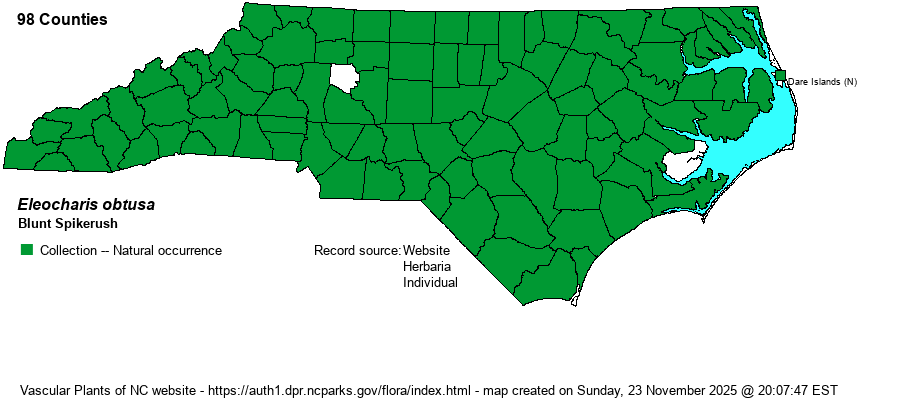| Author | (Willdenow) J.A. Schultes | |
| Distribution | Throughout the state, but rare on the Outer Banks. Our most widespread and usually commonest spikerush.
N.S. to B.C. south to FL, TX, and CA. | |
| Abundance | Common throughout, except rare on the Outer Banks. | |
| Habitat | A wide variety of wet and seasonally wet sites, including marshes, shores of impoundments, beaver ponds, roadside ditches, borrow pits. | |
| Phenology | Flowering and fruiting June-October. | |
| Identification | An annual, this species grows in tufts of many stems. the stems may reach 1.5 feet tall, but normally a foot or less. Stems are generally hollow and easily compressed. The floral scales have a prominent green midrib, and the seeds are bi-convex (lenticular, 2-sided). It is indistinguishable from E. engelmannii but it has a pyramid-shaped seed beak (vs. depressed in that species). | |
| Taxonomic Comments | None
The genus Eleocharis, the spikerushes, are unusual members of the sedge family in that the culms (flowering stems) are round or oval (rarely triangular) in cross-section, rather than triangular in the great majority of our sedges. In addition, leaf blades are absent; just 1-2 basal sheaths are present at the base of the culm. There is a single, cylindrical or narrowly ovoid, spikelet of florets at the culm summit. Details of achene (seed) shape, color, ornamentation, bristle length, and beak (tubercle) shape and size, are critical ID factors. | |
| Other Common Name(s) | None | |
| State Rank | [S5] | |
| Global Rank | G5 | |
| State Status | | |
| US Status | | |
| USACE-agcp | OBL link |
| USACE-emp | OBL link |

